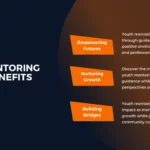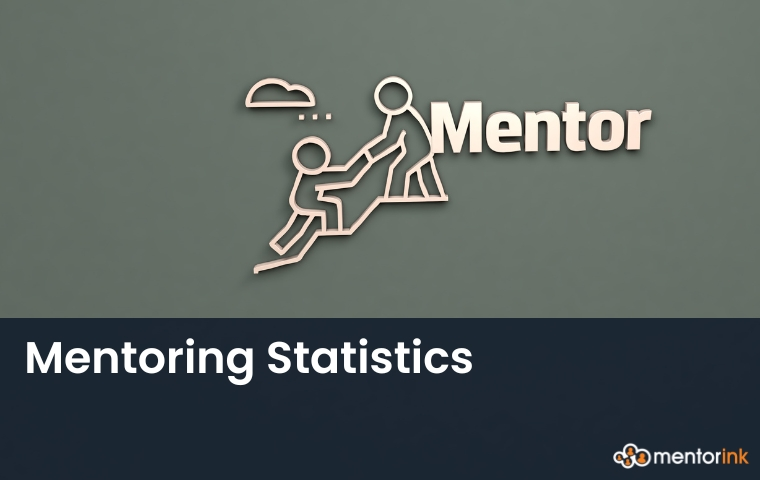
Mentoring has become an essential tool in today’s workplace, driving both employee development and organizational success. Companies across industries are embracing structured mentoring programs to nurture talent, improve retention, and foster leadership growth. The impact of mentoring goes beyond individual advancement, contributing to more inclusive and engaged workforces.
As we head into 2025, the demand for mentoring continues to grow, with organizations recognizing its value in creating supportive environments and boosting productivity. Here’s a look at the latest mentoring statistics within 2024, offering a comprehensive view of how mentoring is shaping the future of work and why it should be a priority for every business.
Mentoring General Statistics
When exploring the benefits of mentoring, it’s essential to recognize its wide-ranging impact on both individuals and businesses. Mentoring drives career development, strengthens leadership, and enhances organizational culture. Below, we highlight key insights on how mentoring is shaping the corporate world and why it remains crucial for success.
- 97.6% of U.S. Fortune 500 companies have mentoring programs. (Forbes, 2024)
- 100% of U.S. Fortune 50 companies have mentoring programs. (Forbes, 2022)
- 76% of professionals believe a mentor is important for growth, yet over 54% do not have a mentor. – (Harvard Business Review, 2020)
- 97% of those with a mentor say it’s valuable. (Sage.com, 2017)
- 55% believe mentoring helps them succeed. (Sage.com, 2017)
- 60% prioritize experience in a mentor above other quality. (Sage.com, 2017)
- 85% currently do not have a mentor. – (Sage.com, 2017)
- 93% of small and medium-sized businesses believe mentoring helps them succeed. – (Sage.com, 2017)
- 30% of mentoring relationships deliver significant learning when neither mentor nor mentee is trained. (Making The Most of Developmental Mentoring, 2013)
- 60% of mentoring relationships succeed when mentors are trained. (Making The Most of Developmental Mentoring, 2013)
- 91% of mentoring relationships are effective when both mentors and mentees are trained and supported, with line managers briefed. – (Making The Most of Developmental Mentoring, 2013)
- Less than 20% of mentoring session time is spent talking by effective mentors, who prioritize listening and helping mentees express their ideas. – (Mentoring and Diversity, 2002)
- Mentors are six times more likely to be promoted compared to those who don’t mentor. – (Forbes, 2011)
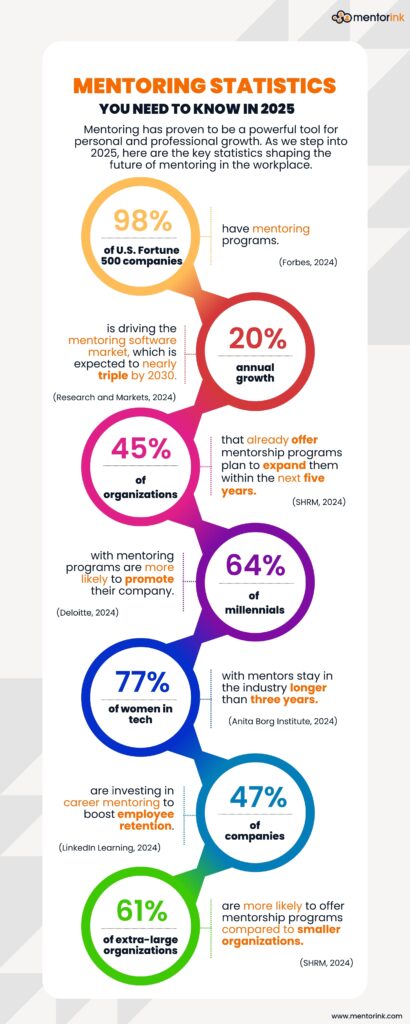
- 55% of businesses saw a positive impact on profits from mentoring. (National Mentoring Day)
- Employees with mentors were promoted five times more often than those without mentors. – (National Mentoring Day)
- 70% of mentored small businesses survive for five years or more, double the rate of non-mentored businesses. – (National Mentoring Day)
Mentoring Statistics for DEI
Mentoring plays a crucial role in driving diversity, equity, and inclusion (DEI) within organizations. By fostering meaningful connections and providing guidance, mentoring helps break down barriers, promote equal opportunities, and support underrepresented groups. In this section, we’ll explore the latest statistics on how mentoring impacts DEI initiatives and why it’s an essential tool for creating more inclusive and equitable workplaces.
- 83% of men understand what’s required for their next promotion, compared to 71% of women, non-binary, transgender, and gender non-conforming individuals. – (Textio, 2023)
- Black employees receive 26% more unactionable feedback than non-Black employees, while receiving 79% as much feedback overall. – (Textio, 2023)
- 95% of mentees see value in having a mentor from a different background. – (Mentoring and Diversity, 2002)
Mentoring Statistics by Gender
- 35% of leaders in companies with strong DEI programs are women, compared to 25% in companies with weak or no DEI programs – (DDI, 2024)
- Only 24% of women leaders have had a formal mentor, compared to 30% of men. – (DDI, 2024)
- Only 27% of senior-level women have had a formal mentor, compared to 38% of men – (DDI, 2024)
- 77% of women in tech with mentors are more likely to stay in the industry after three years than those without mentors – (Anita Borg Institute, 2024)
- 23% of men report receiving more mentorship and sponsorship on-site, compared to 16% of women. – (The Women in the Workplace study by McKinsey & Company, 2023)
- 63% of companies with mentoring programs focused on diversity and inclusion see positive impacts on gender diversity – (Deloitte, 2022)
- 79% of working women do not feel confident enough to ask for a mentor. – (KPMG, 2015)
- 78% of women in senior roles have served as formal mentors at some point in their careers. – (DDI, 2013)
- 63% of women in the study reported never having had a formal mentor. – (DDI, 2013)
- 54% of women reported being asked to mentor only a few times or less in their careers, while 20% have never been asked. – (DDI, 2013)
- 91% of top female executives in Fortune 1000 companies had informal mentors during their careers. – (Mentoring and Diversity, 2002)
Mentoring Statistics for Generations
Millennials
- 86% of Gen Zs and 89% of Millennials say having a sense of purpose is important for their overall job satisfaction and well-being. – (Deloitte, 2024)
- 91% of Millennial professionals consider career progression a top priority when choosing a new job. – (Robert Walters, 2023)
- 53% of Millennials reported disappointment with a lack of personal development training when starting a new job, while only 15% of employers view personalized training programs as a priority for employee engagement. – (Robert Walters, 2023)
- Over 79% of Millennials consider mentoring crucial to their career success. – (Huffpost, 2017)
- 61% of Millennials are benefiting from having a mentor who provides advice or helps develop their leadership skills. – (Deloitte, 2016)
- 68% of Millennials intending to stay with their organization for more than five years are twice as likely to have a mentor, compared to 32% without a mentor. – (Deloitte, 2016)
- 65% of Millennials consider training and growth opportunities the most important retention factor, and 89.6% believe training encourages them to stay with their organization. – (How to measure and adapt to the expectations of millennials entering the Indian workforce, 2014)
- By 2030, 75% of the global workforce will be comprised of Millennials. – (Knowledge sharing as an intervention for Gen Y employees’ intention to stay, 2016)
Gen Z
- 82% of Gen Z believe it’s important for their supervisor to help them set performance goals, while 83% want their supervisor to care about their lives. – (The 74 Million, 2021)
- 60% of white young people know “someone who listens,” compared to 51% of Hispanic/Latino and 41% of Black Gen Z individuals – (Work / Life, 2021)
- 87% of Gen Z individuals want a job that allows them to learn and grow as a person. – (Work / Life, 2021)
Mentoring Statistics for LGBTQ+
- 62% of LGBTQ+ professionals code-switch when meeting with managers or leaders, and 61% do so when asking for a promotion or raise. – (LinkedIn, 2024)
- 90% of LGBTQ+ employees want to be involved in mentoring. – (LGBT Great, 2023)
- 83% of LGBTQ+ employees would like access to specific LGBTQ+-focused development programs. – (LGBT Great, 2023)
- 65% of LGBTQ+ workers reported experiencing harassment at work – (Fondation Émergence, CPQ, & CNESST, 2021)
- 53% of LGBTQ+ workers reported hearing jokes about lesbian or gay people. – (Human Rights Campaign, 2018)
- Nearly 1.1 million of the 3.2 million LGBTQ youth ages 8 to 18 in the United States have never had a mentor, and under 500,000 have had a mentor through a formal or structured program – (UCLA, School of Law Williams Institude, 2014)
- Just over 600,000 of the 1.6 million at-risk LGBTQ youth have ever had a mentor, and fewer than 300,000 have had a formal mentor, meaning over 1.3 million at-risk LGBTQ youth have never had a formal mentoring relationship. – (UCLA, School of Law Williams Institude, 2014)
Mentoring Statistics for the Workplace
Mentoring in the workplace is a powerful driver of employee development, engagement, and retention. It helps employees build skills, gain confidence, and advance in their careers, while also supporting leadership development and knowledge sharing across teams. Whether formal or informal, mentoring programs have proven to increase productivity and job satisfaction. Here are key statistics that demonstrate the significant impact of mentoring in the workplace and why it remains essential for organizational success.
- 89% of mentees go on to become mentors themselves. – (Harvard Business Review, 2015)
- 84% of CEOs credited mentors with helping them avoid costly mistakes. – (Harvard Business Review, 2015)
- 69% reported making more profitable decisions with the guidance of a mentor. – (Harvard Business Review, 2015)
Mentorship and Retention Rate
- 51% of U.S. employees were either watching for or actively seeking a new job – (Gallup, 2024)
- Well-recognized employees are 45% less likely to leave after two years, based on longitudinal data from 2022 to 2024. – (Gallup, 2024)
- 91% of workers with a mentor are satisfied with their jobs, with 57% being “very satisfied.” – (CNBC, 2019)
- Over 40% of workers without a mentor have considered quitting in the past three months, compared to just 25% of those with a mentor. – (CNBC, 2019)
- Retention rates were 72% for mentees and 69% for mentors, compared to 49% for those not in the mentoring program. – (MI Blue Daily, 2019)
- Mentoring programs yield an ROI of 600% of the costs and increase employee retention. – (Wharton School of the University of Pennsylvan, 2007)
Mentorship and Stress Reduction
- 56% of American workers say their boss is mildly or highly toxic, and 75% report that dealing with their manager is the most stressful part of their workday. – (McKinsey, 2024)
- 84% of workers say poorly trained managers create unnecessary stress. – (SHRM, 2020)
- Mentoring alleviates situational anxiety, enhances student participation and competence, and fosters self-confidence and positive outcomes among nursing students by reducing stress and anxiety. – (Effects of peer-mentoring on stress and anxiety levels of undergraduate nursing students: An integrative review, 2019)
- Mentoring reduced anxiety and improved mental health for both mentors and mentees, according to a study by the University of Cambridge Judge Business School. – (Mentoring for mental health: A mixed-method study of the benefits of formal mentoring programmes in the English police force, 2018)
Mentorship for Learning and Growth
- 7 in 10 people say learning improves their sense of connection to their organization. – (LinkedIn, 2024)
- 8 in 10 people say learning adds purpose to their work. – (LinkedIn, 2024)
- Twice as many employees with growth and development support are engaged, and 98% are more likely to strongly agree they’d recommend their organization as a great place to work. – (Gallup, 2023)
- 75% of employees with formal mentors and 97% with formal sponsors strongly agree their organization provides a clear career development plan, compared to those with informal mentors and sponsors. – (Gallup, 2023)
- Employees with formal mentors or sponsors are 38% more likely to strongly agree they have someone at work who helps them reach their career goals, compared to those with informal mentors or sponsors. – (Gallup, 2023)
Leadership Development Through Mentorship
- Employees with formal mentors are 58% more likely, and those with formal sponsors are 48% more likely, to strongly agree that their workplace provides equal opportunities for advancement to senior management. – (Gallup, 2023)
- 84% said mentors helped them achieve competence in their roles faster. – (Harvard Business Review, 2015)
- 70% of individuals with a mentor experience improved work performance and leadership development – (The International Coach Federation)
Mentorship and Productivity
- 67% of businesses reported increased productivity due to mentoring. – (National Mentoring Day)
- The skills mismatch affects 1.3 billion people globally, and 6% of revenue is lost worldwide due to its impact on productivity – (BCG, 2020)
Mentorship, Promotions, and Salary Growth
- 79% of workers with a mentor say they’re well paid, compared to 69% without a mentor, and 89% feel their contributions are valued by colleagues, compared to 75% without a mentor. – (CNBC, 2019)
- 25% of employees in a mentoring program had a salary-grade change, compared to 5% of non-participants. – (MI Blue Daily, 2019)
- Mentors were promoted six times more often than those not in the program. – (MI Blue Daily, 2019)
- Mentees were promoted five times more often than those not in the program. – (MI Blue Daily, 2019)
Mentoring Statistics Across Industries
Mentoring plays a critical role in driving success across various industries, from tech and finance to healthcare and education. By fostering knowledge transfer, skill development, and leadership growth, mentoring programs help organizations thrive and employees reach their full potential. In this section, we explore key statistics that highlight the impact of mentoring across different sectors.
Mentoring Statistics for Healthcare
- 77% of women mental health practitioners believe mentorship is critical for career success, but only 26% currently have a mentor. – (Simple Practice, 2023)
- 96% of participants agree that mentorship is crucial for career progression, yet 71.2% report not having a mentor. – (Professionalization and Retention Outcomes of a University–Service Mentoring Program Partnership, 2011)
- 80% reduction in vacancy rates observed in one hospital after introducing a mentoring program. – (Professionalization and Retention Outcomes of a University–Service Mentoring Program Partnership, 2011)
Mentoring Statistics for Finance
- One-third of successful entrepreneurs have relied on a mentor or support group, compared to only 14% of entrepreneurs with failed businesses. – (XERO, 2023)
- 41% of women agreed, and 7% strongly agreed that having a mentor increases loyalty to their current employer. Additionally, 61% agreed or strongly agreed that a mentor helped them perform better at work. (The Influence of Mentorship and Sponsorship on Women in the Financial Services Industry, 2022)
- 63% of women and 70% of men agree that mentorship has been crucial for career mobility. Additionally, 25% of women agreed and 15% strongly agreed they wouldn’t be in their current role without a mentor. – (The Influence of Mentorship and Sponsorship on Women in the Financial Services Industry, 2022)
- 22% of small businesses had mentors at startup, 17% had an advisor, leaving 63% without professional guidance when starting their business. – (NFIB, 2019)
- 61% of small business owners mentor others, and 58% mentor younger entrepreneurs. – (NFIB, 2019)
- 33% of founders mentored by successful entrepreneurs become top performers. – (TechCrunch, 2015)
Mentoring Statistics for Youth
Mentoring has a profound impact on youth, shaping their personal growth, academic success, and future opportunities. Below are key statistics highlighting the importance of mentoring for young people.
- 86% of children ages 6 to 17 have at least one adult mentor in their school, neighborhood, or community who provides advice or guidance. – (Child Health Data, 2022)
- 92% more likely to volunteer regularly in their communities. – (MENTOR, 2014)
- 75% more likely to have held a leadership position in a club or sports team. – (MENTOR, 2014)
- 22% more likely to have experienced a strong sense of belonging while growing up. – (MENTOR, 2014)
- 74% of those who had a meaningful mentor say that person contributed significantly to their success later in life. – (MENTOR, 2014)
- 85% of young people with a mentor say this key relationship has helped them with issues related to school and their education. – (MENTOR, 2014)
- 58% of young people say their mentor has supported their mental health. – (MENTOR, 2014)
- 60% of those under 40 years old are still drawing advice from their childhood mentors. – (MENTOR, 2014)
- 52% of students who meet regularly with their mentors are less likely to skip a day of school, and 37% are less likely to skip a class. – (Youth Mentor)
- 46% of youth who meet regularly with their mentors are less likely to start using illegal drugs, and 27% are less likely to start drinking. – (Youth Mentor)
- 76% of at-risk young adults with a mentor aspire to enroll in and graduate from college, compared to 50% of those without a mentor, and they are also more likely to be enrolled in college. – (Youth Mentor)
- Mentoring reduces “depression symptoms” and increases “social acceptance, academic attitudes and grades.” – (Youth Mentor)
Mentoring Statistics for Universities
Mentoring is vital in universities, enhancing student success, retention, and career readiness. Here are key statistics showing the impact of mentoring in higher education.
- 61% of male students are trained by award-winning mentors, compared to 50% by top-decile non-award-winning mentors. – : (Impact of gender on the formation and outcome of formal mentoring relationships in the life sciences, 2022)
- 64% of recent graduates who had a mentor during college say their mentor was a professor. – (Strada, Gallup, 2018)
- 72% of white graduates say their mentor was a professor, compared to 47% of minority graduates. – (Strada, Gallup, 2018)
- 92% of recent graduates with a mentor received guidance on academic issues, and 90% received career guidance. – (Strada, Gallup, 2018)
- 54% of alumni received mentoring advice on personal issues, and 53% on physical or mental health. In the strongest mentoring relationships, 62% received advice on personal life or relationships. – (Strada, Gallup, 2018)
- 20-30% higher retention rates are observed in academic and professional settings with mentoring programs. (Examining Youth Mentoring Services Across America: Findings from the 2016 National Mentoring Program Survey, 2017).
- 74–77% of students in the mentoring program graduate, compared to 55.9% of the general STEM student population at LSU. – (Hierarchical Mentoring: A Transformative Strategy for Improving Diversity and Retention in Undergraduate STEM Disciplines, 2011)
Mentoring is a powerful tool that drives personal and professional growth, boosts productivity, and enhances employee retention. The statistics clearly show its significant impact across various sectors, from youth development to the workplace. Investing in mentoring programs benefits both individuals and organizations, contributing to long-term success.
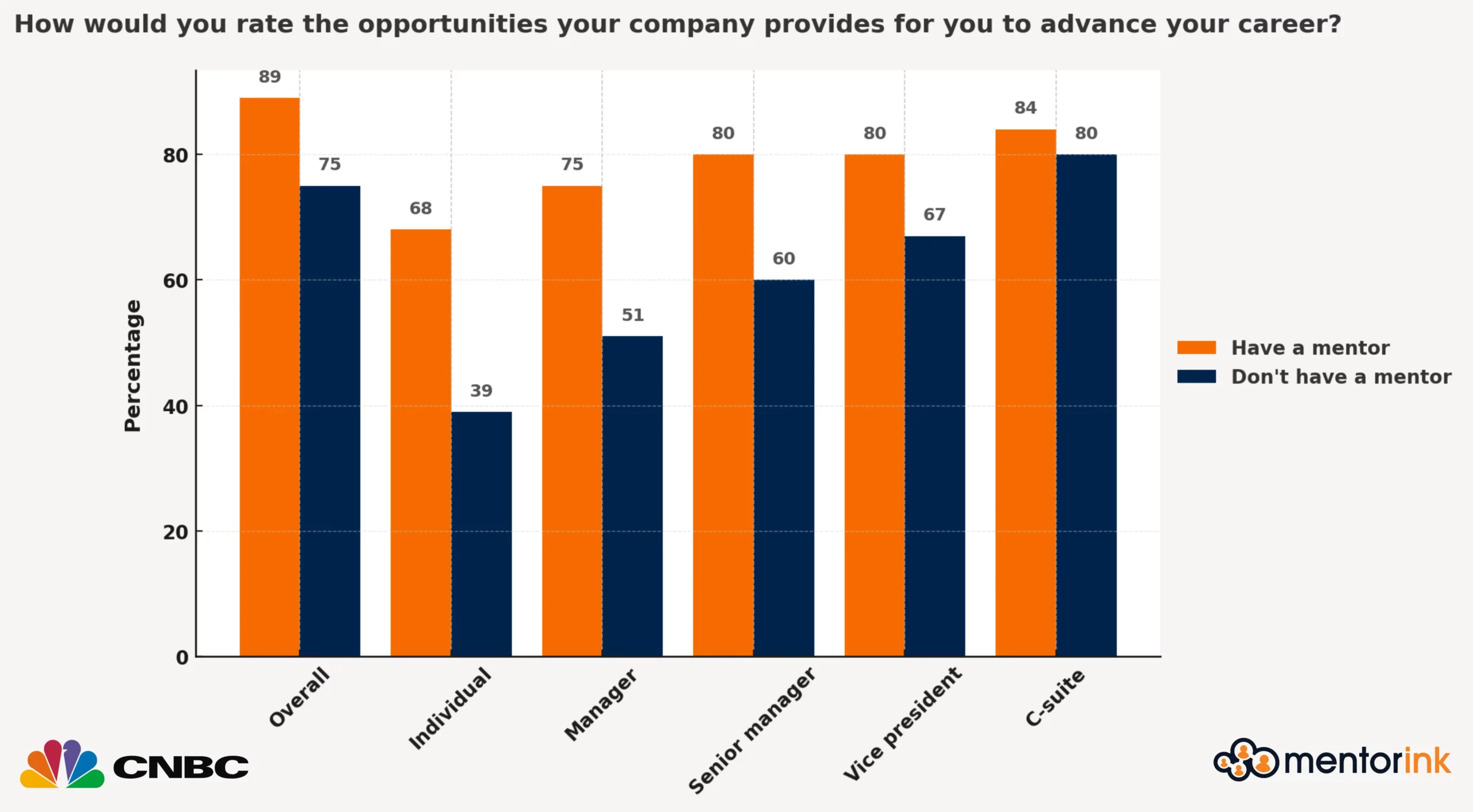 (
(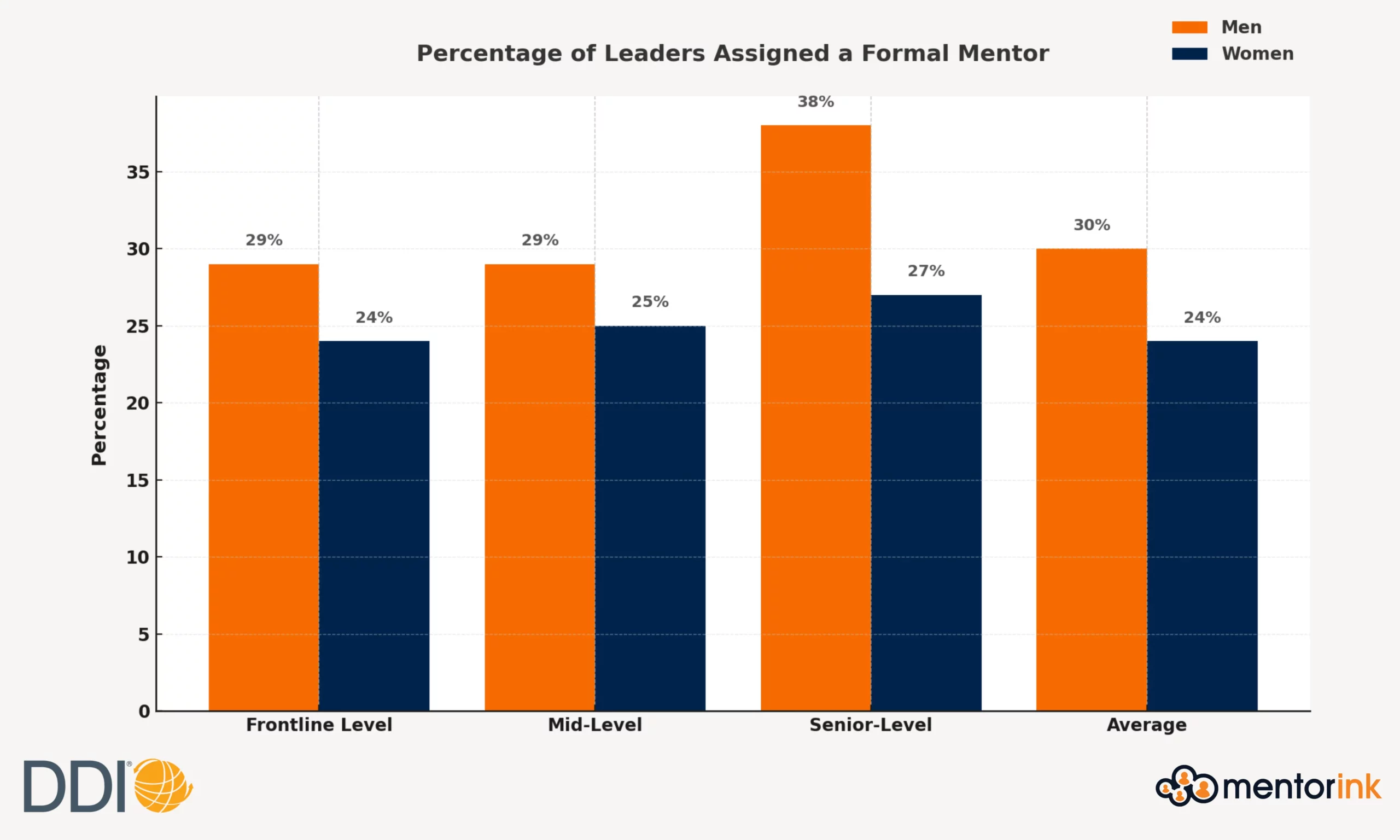 (
(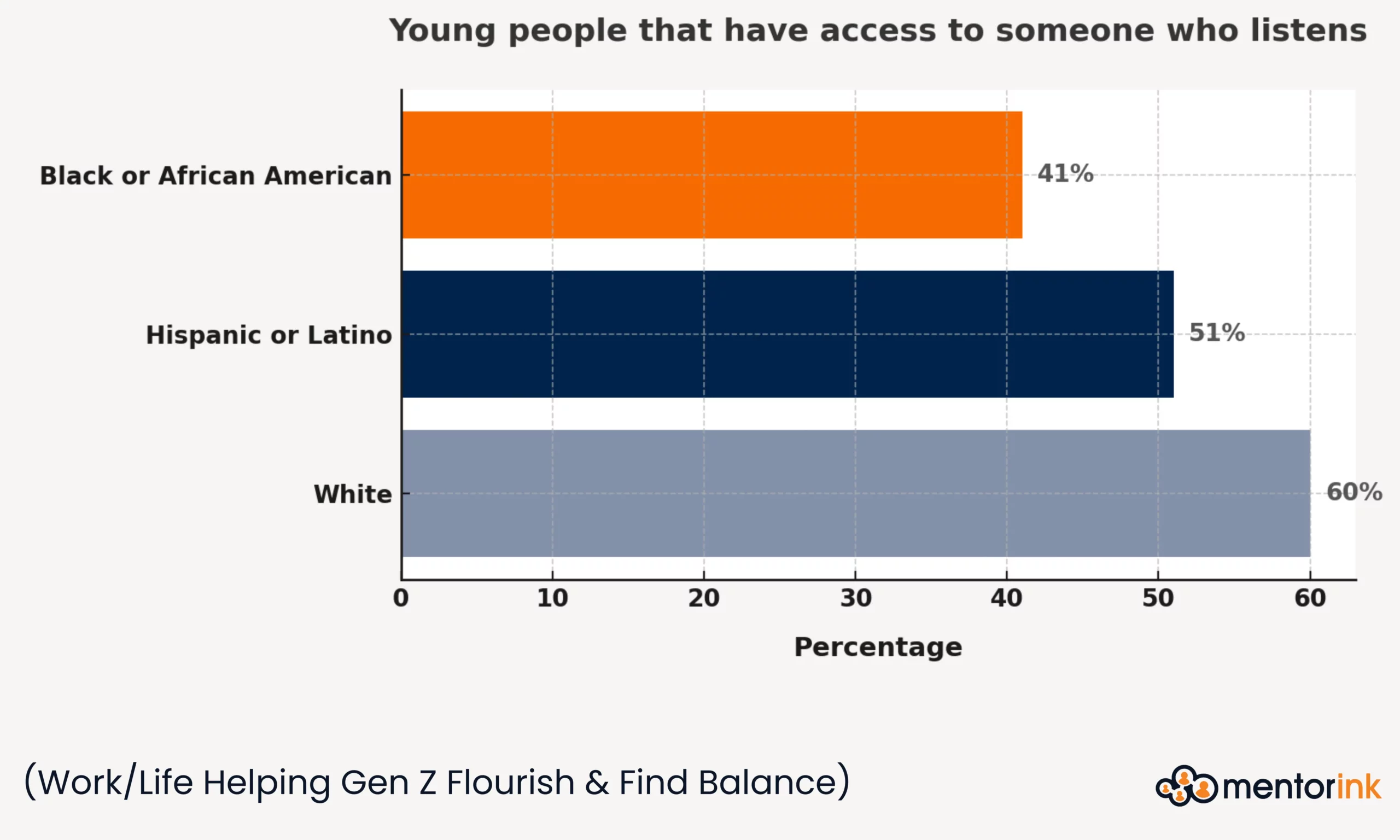 (
(
